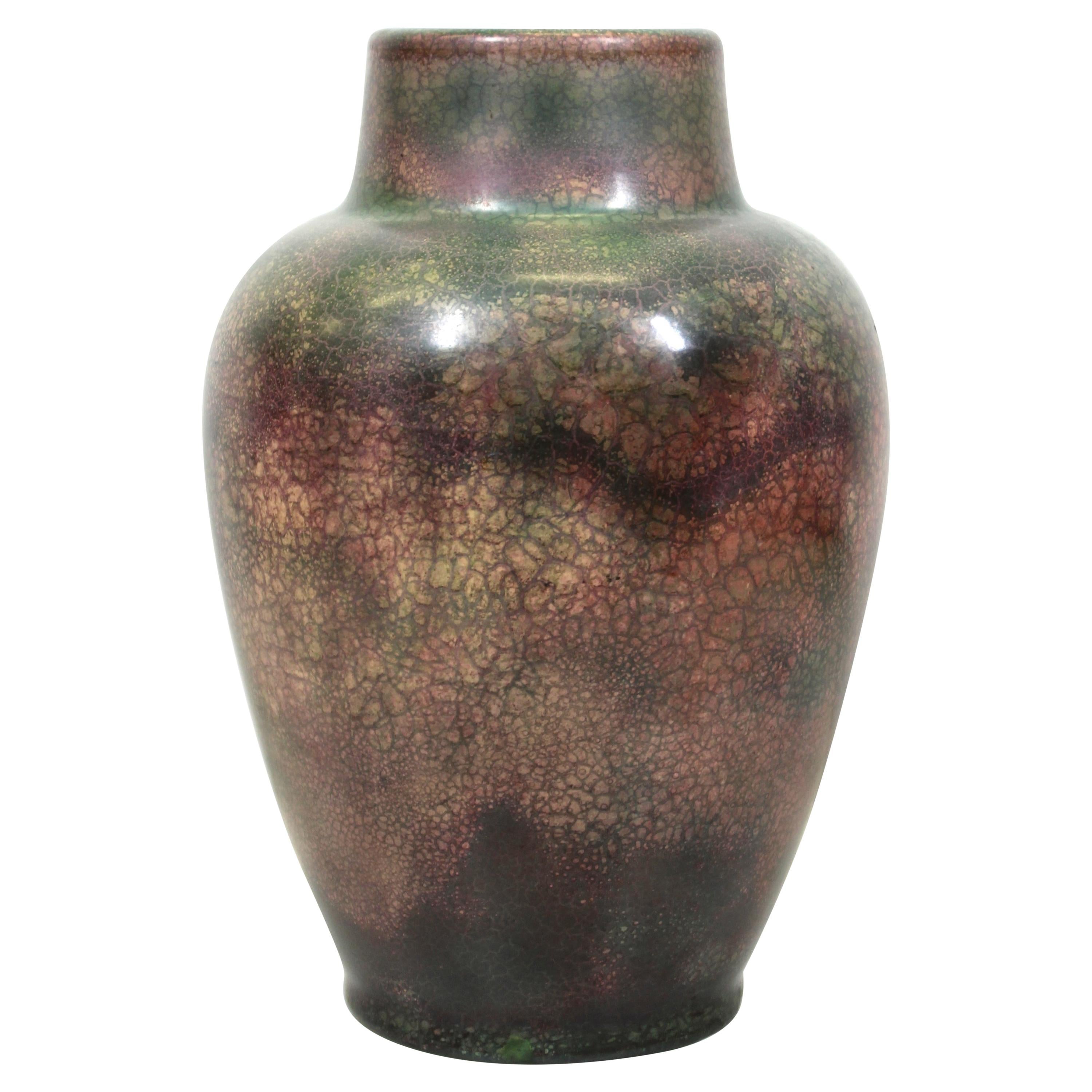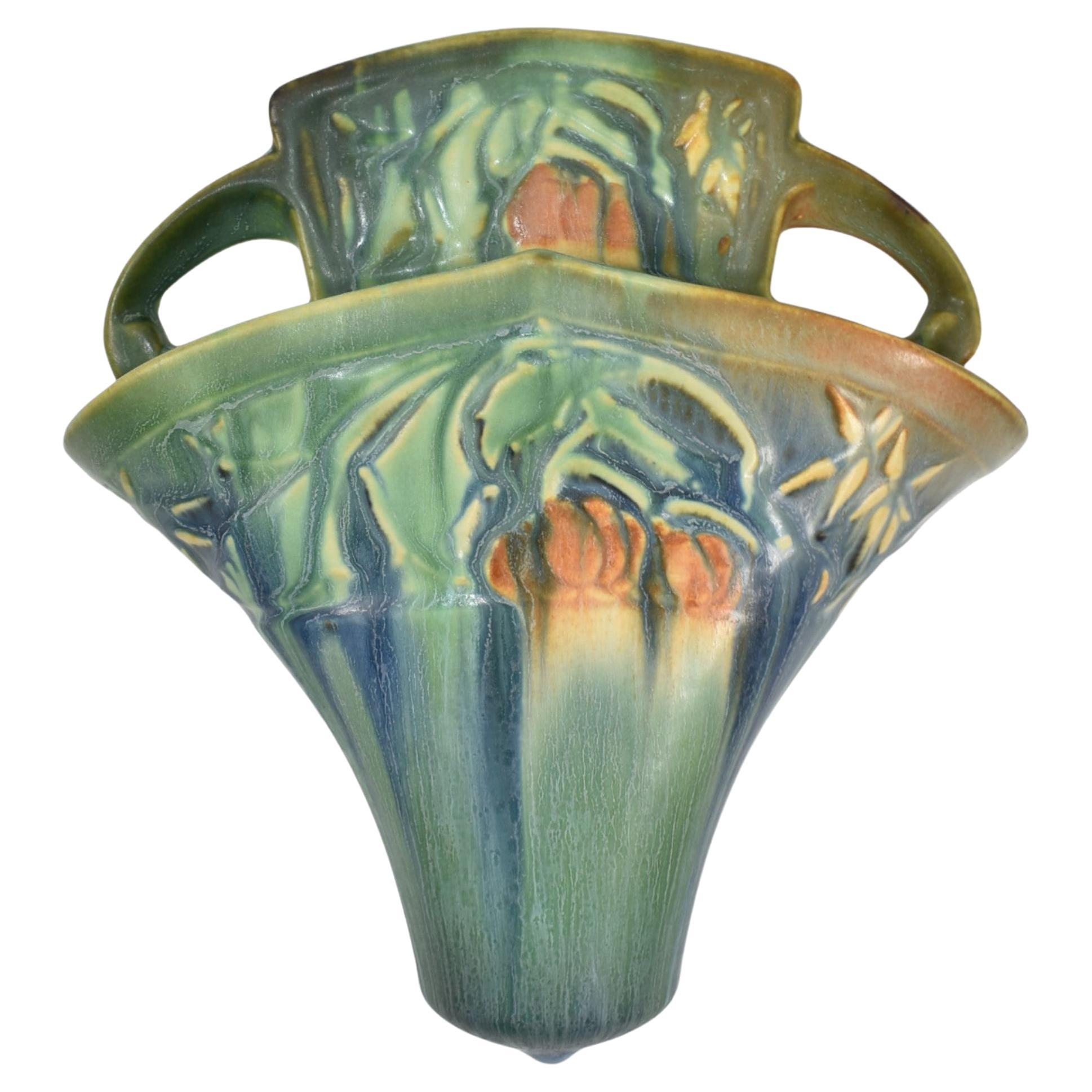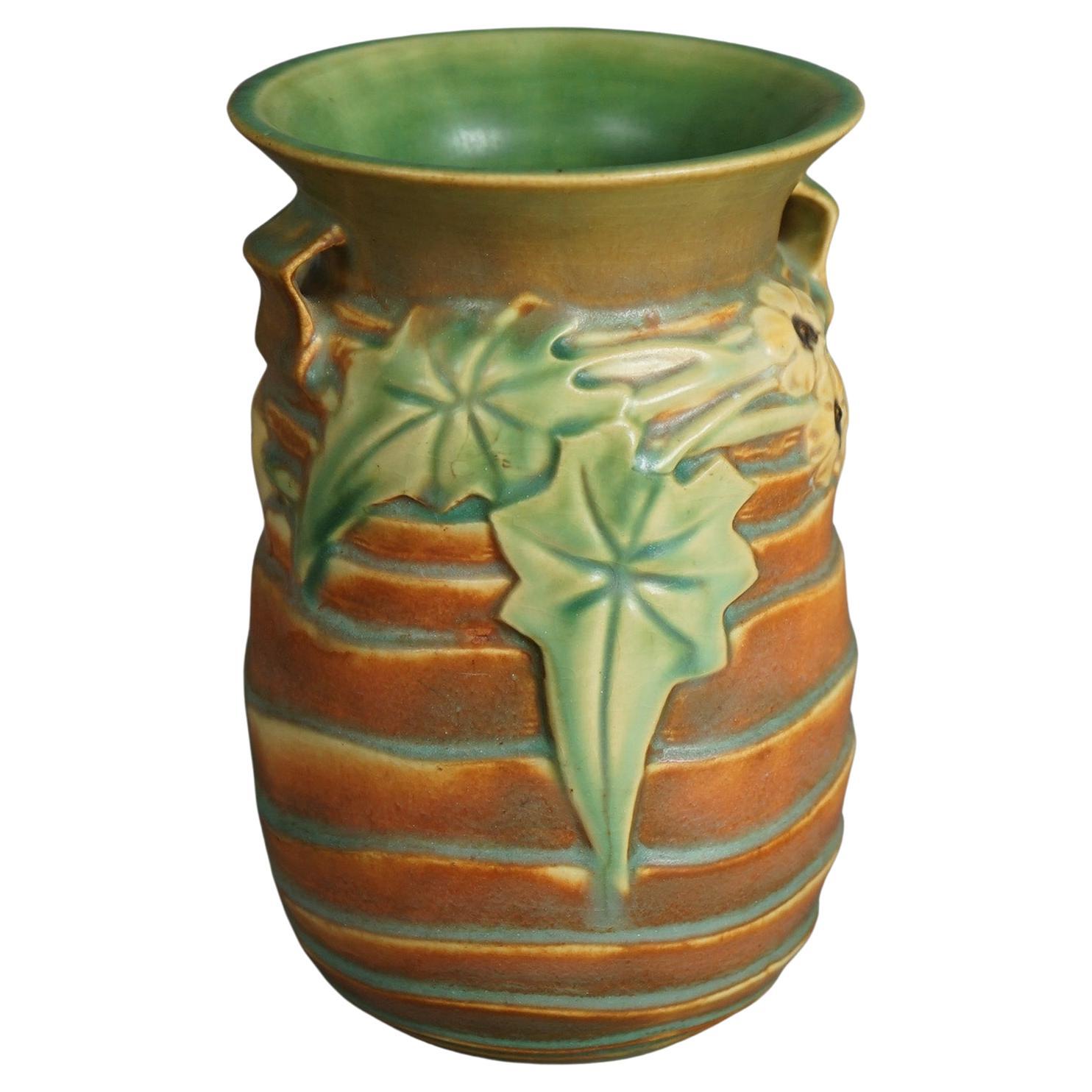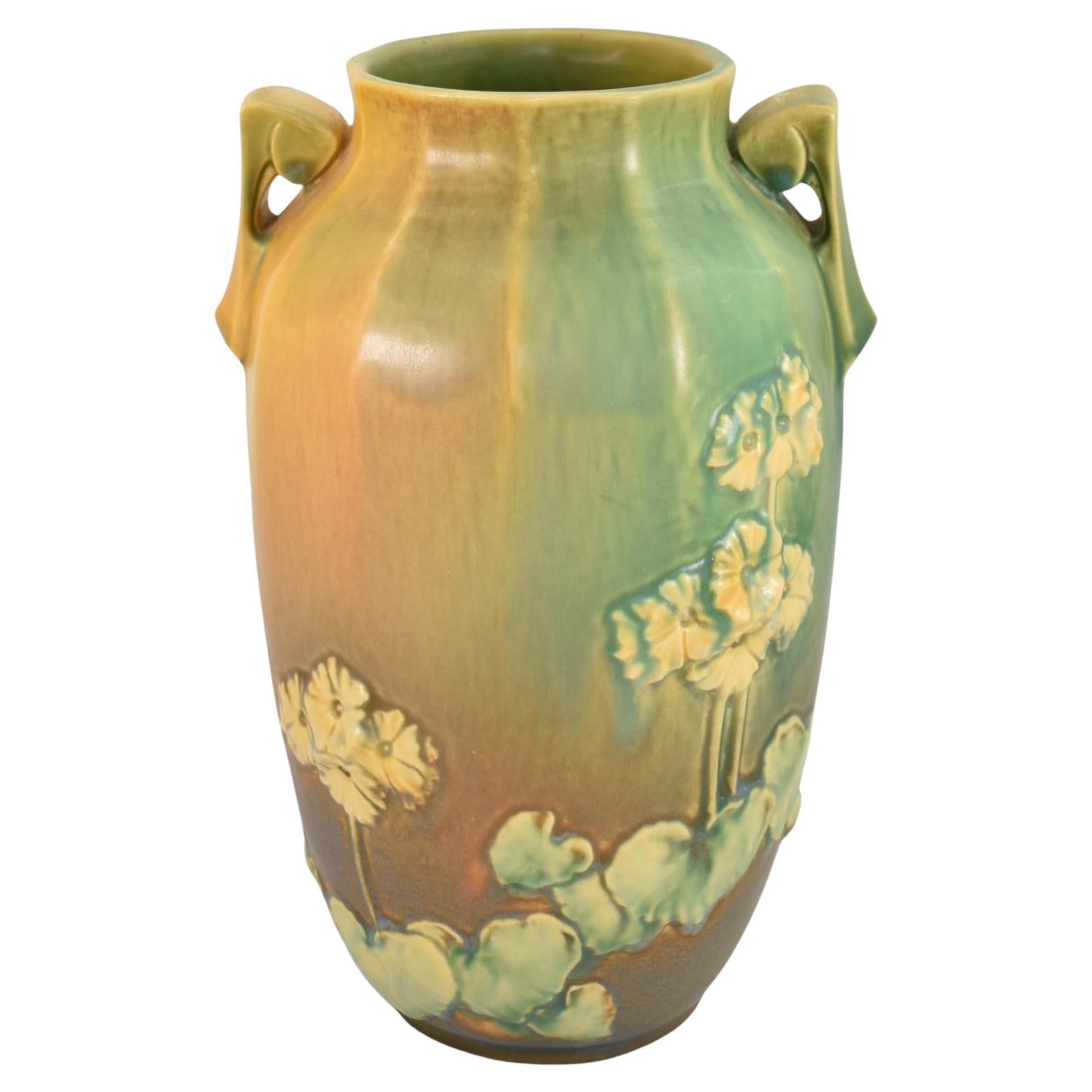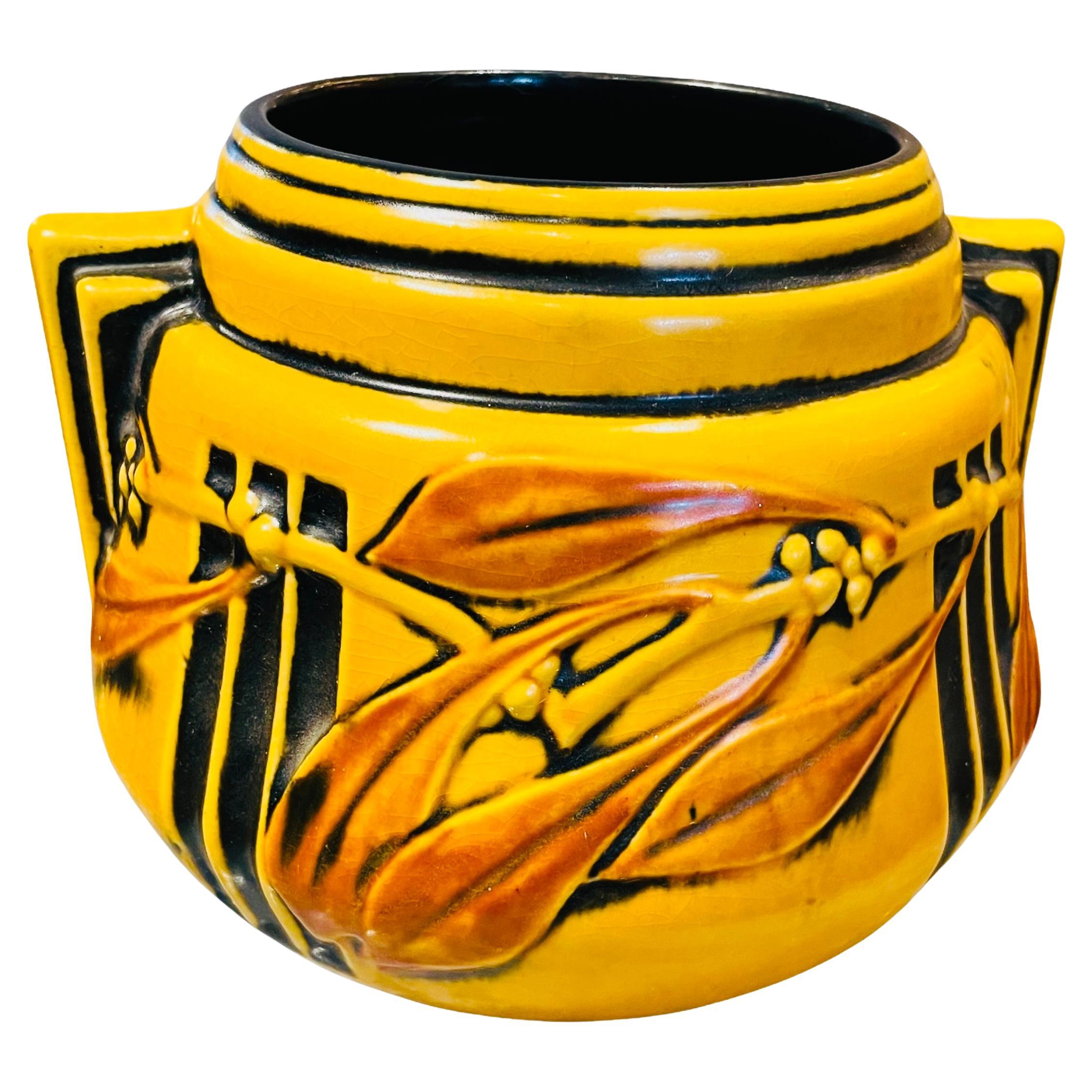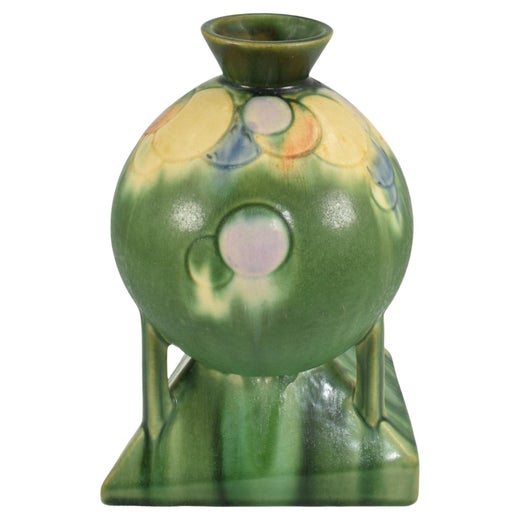Roseville for Tiffany, Arts & Crafts Chinese-Form Ceramic Vase, ca. 1900
About the Item
- Creator:Roseville Pottery (Maker)
- Dimensions:Height: 15.75 in (40.01 cm)Diameter: 10.5 in (26.67 cm)
- Style:Art Nouveau (Of the Period)
- Materials and Techniques:Ceramic,Glazed
- Place of Origin:
- Period:1900-1909
- Date of Manufacture:ca.1900
- Condition:Wear consistent with age and use. We make our best effort to provide a fair and descriptive condition report. Please examine photos attentively for they are an important part of the description. Send us a message to request more details or discuss price.
- Seller Location:New York, NY
- Reference Number:1stDibs: LU2819339549982
Roseville Pottery
Along with Stickley furniture and the copper lamps of Dirk van Erp, the works of the Roseville Pottery Company are treasured staples of the American Arts and Crafts movement. The straightforward naturalism of vintage Roseville bowls, vases, dishes and other ceramics represent a frank, American aesthetic distinct from the more stylized European Art Nouveau works of the same period. Roseville Pottery works are the essence of honest artisanry.
Founded in Roseville, Ohio, in 1890, the company originally focused on flowerpots, mixing bowls, and other household items, but branched out into art pottery in 1900. An early manifestation of the Arts and Crafts movement in the United States — which celebrated traditional craftsmanship and would influence designers and architects including Frank Lloyd Wright — was Fulper, Rookwood and Roseville pottery. Hand-painted florals and gourd-like shapes were the pieces’ most obvious characteristics.
Roseville pottery typically features decorative motifs inspired by nature — the company’s Pinecone and Blackberry patterns are perennial favorites among collectors — and glazes in warm, earthy shades of brown and gold.
Roseville's Pinecone pattern was the brainchild of art director Frank Ferrell, who sculpted the prototype for each piece by hand. His most successful ideas went into mass production, while others were limited to only a few experimental pieces. These “experimentals” are now the most sought-after Roseville wares — look for the official Roseville pottery marks on the bottom or side of a piece, along with a number or (in some cases) even a note.
As you will see from the items on these pages, Roseville Pottery produced ceramics of timeless and enduring warmth and beauty. They merit a place in every collection of American design.
Find vintage Roseville bowls, vessels and other works for sale on 1stDibs.
- ShippingRetrieving quote...Ships From: New York, NY
- Return PolicyA return for this item may be initiated within 10 days of delivery.
- Frederic Rhead, a Pair of Arts & Crafts Terracotta Vases with Peacocks, ca. 1900By Frederick Hurten RheadLocated in New York, NYFrederic Rhead, a pair of English Arts & Crafts Glazed terracotta vases with Peacocks, circa 1900. This outstanding pair of English Arts & Crafts gla...Category
Antique Early 1900s English Arts and Crafts Vases
MaterialsTerracotta
- Paul Dachsel for Turn Teplitz, Austrian Jugenstil Ceramic ‘Fern’ Vase, ca. 1900By Paul DachselLocated in New York, NYDETAILS: Fully marked on bottom. DIMENSIONS: height: 6.75 inches, width: 4.5 inches, depth: 4.5 inches ABOUT THE ARTIST Paul Dachsel (Czech, born circa 1880) was the son-in-law of Alfred...Category
Antique Early 1900s Austrian Art Nouveau Vases
MaterialsCeramic
- French Beaux Arts, Patinated Bronze Figural Vase by A. Bofill, Ca. 1900By Antoine BofillLocated in New York, NYAntoine Bofill (Spanish-French, 1875-1925) was a Spanish artist and member of the Animalier movement of the 19th century. Best known for his small, decorative bronze sculptures, Bofi...Category
Antique Early 1900s French Beaux Arts Vases
MaterialsBronze
- French Art Nouveau Patinated Bronze Sculptural Iris Vase, ca. 1900Located in New York, NYABOUT IRIS The iris is a special and mysterious flower. Not only because of its striking appearance, but also from an artistic and historical point of view. It is also like a work of art, as though created by Mother Nature. The unique leaves of this plant not only create wonderful shadow casts, but also look as if they were painted by hand. It's no wonder that iris acts as the muse for countless artists, and can be seen in many famous works of art. The iris was first spotted in the time of Pharaoh Thutmose, in 1504 BC. He had the iris inscribed into the wall reliefs of a temple as a sign of his power, as well as decorating his sceptre with motifs of the flower. Since then, the iris has been a symbol of victory in Egypt. But the symbolism of the iris goes further than that. In Japan, the flower represents courage and is the symbol of the boys' festival. In Islamic cultures, the iris is a symbol of prosperity. In Europe, the flower was a popular weapon symbol in the Middle Ages and stood for chivalry. And in Christianity, the iris was seen as a symbol of the trinity because of its three-part flowers. With more than 300 varieties, the iris is now the most popular flower among growers and gardeners following the rose. Countless artists use the iris in their works and the flower is present in all eras. You can see the flower on furniture, vases, jewelry, fabrics, sculptures, coats of arms and much more. Did you know that the iris is also called the sword lily? It's not a coincidence that it used to symbolize physical and emotional pain and suffering caused by a weapon. We also see the flower in religious art, where it's often associated with Mary and Jesus. The iris is also associated with the Greek goddess Iris, where the flower symbolizes reconciliation and divine messages. This is also reflected in many paintings. Finally, the iris is also visible in Dutch and Flemish still-life paintings. This can be in a religious form, incorporated into an object or as a decorative flower. In the Art Nouveau art movement, the iris (along with other plants, such as the birch) was often used as an expression of feminine beauty. With its almost otherworldly appearance, the iris is perfectly suited to the Art Nouveau aesthetic and is featured in many well-known works of art. The poet of that era, Hermann Hesse...Category
Antique Early 1900s French Art Nouveau Planters, Cachepots and Jardinières
MaterialsBronze
- After Loetz, Bohemian Jugendstil Iridescent Art-Glass Flower Vase, ca. 1900By Loetz GlassLocated in New York, NYThis large elegant, museum quality flower vase was probably made by Johann LOETZ Witwe Glassworks (Klostermühle, Bohemia, circa 1900) is a superior example of Jugendstil ~ Art Nouveau luxury object. The semi-translucent art glass strikes a spectator not only with the uniqueness of its surface, reminiscent of crocodile skin, but also with unexpected color scheme - a combination of dark brown, old gold and green, covered with craquelure; against the background of iridescent violet. The vase is framed by outstandingly designed bronzed & patinated pewter mounting, consisting of simple large handles, almost geometric-form; with one wreath of leaves, crowning the neck; and the second, forming a base. The simplicity of the forms both, the glass vessel and the mounting are generating extremely interesting decorative effects, inherent exclusively to Jugendstil ~ Art Nouveau era. LOETZ Witwe Glassworks In 1836, Johann Eisner established a glassworks in the Southern Bohemian town of Klostermühle, today part of the Czech Republic. The Art Nouveau Period was the glory years of the company. The glassworks created large numbers of its own new designs of iridescent, trailing art nouveau glass, sometimes in collaboration with well-known artists and designers like Marie Kirschner and Franz Hofstötter (aka Franz Hofstätter). The company’s success during this period had two prime drivers – the technical expertise of Prochaska and the business acumen of von Spaun. Loetz Witwe created many of its own designs, and also supplied glass commissioned by major customers like E. Bakolowits (Vienna) and Max Emanuel...Category
Antique Early 1900s Czech Art Nouveau Vases
MaterialsArt Glass
- French Art Nouveau Iridescent Stoneware & Bronze Vase or Cachepot, ca. 1900sLocated in New York, NYFrench Art Nouveau Ocean Life Theme Vase Cachepot Iridescent Stoneware & Patinated Bronze Crab Appliqué ca. 1900s ABOUT We present here a most unusual and utterly decorative Fren...Category
Antique Early 1900s French Art Nouveau Vases
MaterialsStoneware
- Roseville for Tiffany Chinese Form Pauleo Ceramic VaseBy Roseville PotteryLocated in New York, NYAmerican Arts & Crafts Chinese form ceramic vase with craquelure technique, made by Roseville with the Pauleo pattern and retailed at Tiffany. This extremely rare piece of ceramic wa...Category
Antique Early 1900s American Arts and Crafts Vases
MaterialsCeramic
- Roseville Baneda Green 1932 Arts And Crafts Pottery Ceramic Wall Pocket 1269-8By Roseville PotteryLocated in East Peoria, ILRoseville Baneda Green 1932 Arts And Crafts Pottery Ceramic Wall Pocket 1269-8 Wonderful and rarely seen wall pocket with great color. Excellent original condition. No chips, cracks...Category
Vintage 1930s Arts and Crafts Vases
MaterialsClay
- Roseville Tourist Creamware 1916 Arts And Crafts Pottery Flaring Rim Flower VaseBy Roseville PotteryLocated in East Peoria, ILRoseville Tourist Creamware 1916 Arts And Crafts Pottery Flaring Rim Flower Vase Rare and superior scenic vase with clean design and great color. Excellent condition. No chips, crack...Category
Vintage 1910s Arts and Crafts Vases
MaterialsClay
- Antique Arts & Crafts Roseville Luffa Pattern Pottery Vase C1930Located in Big Flats, NYAn Arts and Crafts Roseville vase offers art pottery construction in the Luffa pattern, maker label on base as photographed, c1930 Measures- 7.5''H x 4.75''W x 4.75''DCategory
Early 20th Century American Arts and Crafts Vases
MaterialsPottery
- Roseville Primrose Experimental Trial Glaze 1936 Vintage Pottery Ceramic VaseBy Roseville PotteryLocated in East Peoria, ILRoseville Primrose Experimental Trial Glaze 1936 Vintage Pottery Ceramic Vase Exceptional, one of a kind Roseville experimental vase decorated with primrose flowers. Superior mold, c...Category
Vintage 1930s Art Deco Vases
MaterialsClay
- Roseville Pottery Laurel Pattern VaseBy Roseville PotteryLocated in Guaynabo, PRThis is a Roseville Pottery Laurel pattern round shaped vase. The vase has a yellow color background decorated with black wide vertical bands. It is also adorned with a relief of Lau...Category
Early 20th Century American Arts and Crafts Vases
MaterialsClay
